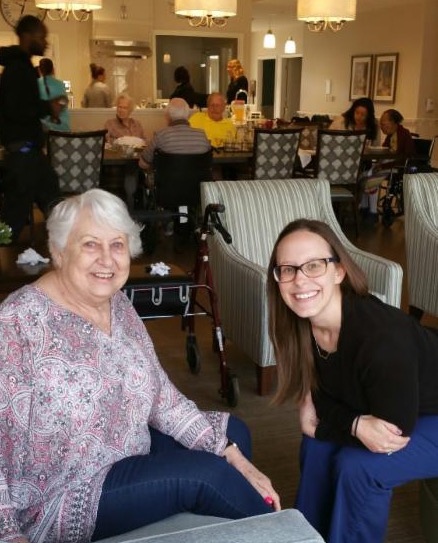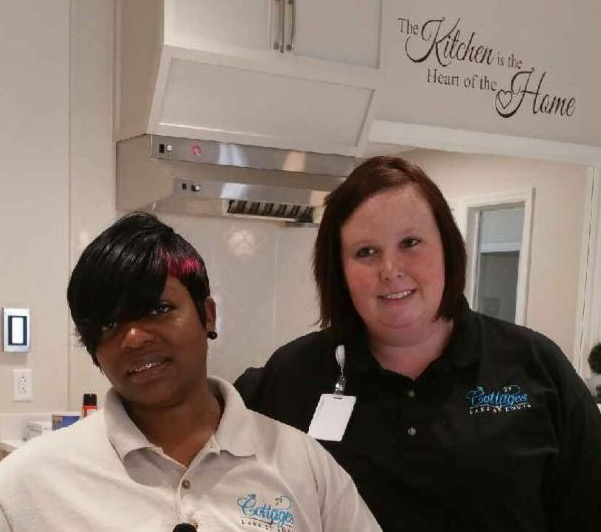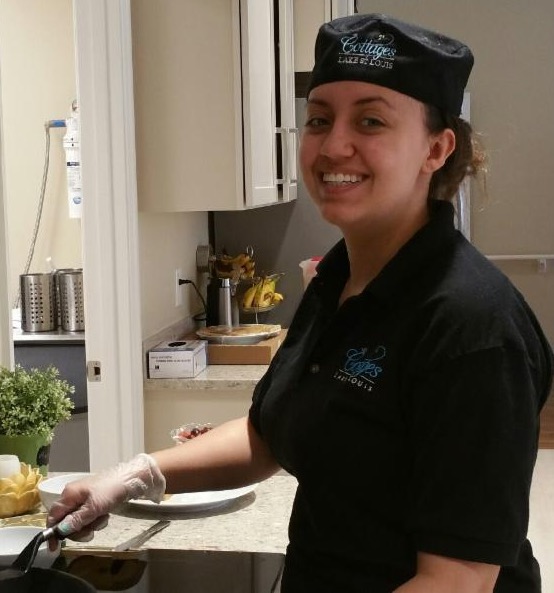By the Care Partners of the Cottages of Lake St. Louis with Sherry King, Administrator
INTRODUCTION
by Joan Devine
Last week in the Pioneer Network Hot Topics Webinar, we heard from Sue Misiorski and Anna Ortigara from PHI about the workforce crisis, and about how changes need to occur in organizational design in order to create homes where staff are satisfied and feel they are making a contribution. Certainly, this is very much a part of what culture change is all about, and what many communities, embracing many different models of care, are aspiring to do.
I recently had the opportunity to visit the newest Green House® community in the country, which as fate would have it, is about 10 miles from my home. There I had lunch with the Elders and Care Partners, and had a chance to join in the convivium that takes place at mealtime. I was inspired by the sense of satisfaction and pride I heard in the voices of the Care Partners, and so I am pleased to share with you their comments and commentary about work in a Green House® home. Whether your community is a Green House® home, another Small House model, a community in transition or a traditionally built nursing home, there is something to learn from these Care Partners — something to apply in your setting and bring to your culture.
Working in a Green House® Home Feels “Just Like Home” to These CNAs
 When Marissa Redding compares her job working as a care partner (another name for caregiver) at The Cottages of Lake St. Louis with her previous job at a large nursing home, she says “the difference is night and day.”
When Marissa Redding compares her job working as a care partner (another name for caregiver) at The Cottages of Lake St. Louis with her previous job at a large nursing home, she says “the difference is night and day.”
What’s the main difference?
“The person-centered care,” says Redding. “The Elders guide how they want their care and how they want their day to go. They have voices here.”
Person-centered care is a core value of THE GREEN HOUSE® Project, a radically new model of residential skilled nursing care that returns control, dignity and a sense-of-wellbeing to Elders, their families, and the staff who care for them. The Cottages of Lake St. Louis is the first Green House® community in Missouri.
A Greater Voice — for CNAs and Elders
Redding says she and her coworkers have a much greater voice in Green House® homes, too.
“I feel like we are heard, even by upper management. Any changes that need to occur actually happen, and issues that arise are addressed,” she says.
Self-directed teams provide a great deal of flexibility in scheduling, keeping the house clean, caring for Elders, and communicating with one another as concerns crop up.
“Choices can be made by the group,” says Redding. “We hold each other accountable, because we work closely together.”
Redding offered an example of the concept in action:
“The other day, they had three of us staffed. I came in sick, they sent me home, and I made up the shift two days later. As long as the Elders’ needs are met — and there are enough people here to take care of them — we can make decisions like that.”

No Set Schedules, More Time to Bond
Keke Moore is also a care partner at The Cottages. Moore says working in a Green House® home is “not as overwhelming as being in a traditional setting.”
The first reason is the size. Compared to a traditional nursing home, a Green House® home is downright diminutive. The Cottages of Lake St. Louis is six cottages that house no more than 10 Elders each, all with private bedrooms.
Even more important to Moore: there are no set schedules.
“Nobody eats at the same time,” says Moore.
Everything — waking, meals, bathing, care, exercise and activities — is determined by the needs and desires of the Elders.
“They’re not rushed, so we’re not rushed,” Moore explains.
This more organic approach to care allows the staff and residents to get to know one another.
“In a traditional nursing home, you could only spend 20 minutes in a room because there’s a schedule,” Moore explains. “Let’s say we have a resident who wants to have her shower, then she wants to chit chat with you after the shower. You actually have time to do that here.”
 Just Like Home
Just Like Home
The design of Green House® homes encourages the low-stress interactions that naturally happen in a home — and the family-style kitchen with one large table where everyone eats is at the center of it all.
“We sit down, just like at home, and eat with them,” says Moore.
All care partners also cook. Sometimes, the Elders join in.
“We had one little lady who would bake with us in the kitchen,” says Redding. “She would smash up bananas for the banana bread and throw cookies on a pan.”
Research shows that Elders who live in Green House® homes experience four times the social interactions than occur at traditional nursing homes. And because each cottage has its own dedicated staff, care partners and Elders get to know each other on a one-to-one basis.
“You feel more like a family,” says Moore.
Both Redding and Moore say working in a Green House® home provides them the flexibility, resources and environment to do what motivated them to go into this field in the first place: care for people.
“You go home feeling like you did good. You go home lighthearted — and when you come back, it doesn’t feel like you’re going to work,” says Redding. “You feel like you’re coming into a household.”
“It’s like home away from home. I get to sit down and watch TV with them. I can eat with them. I can laugh with them,” says Moore. “It’s like I leave home, and I come home. I like that.”
Want to learn more about the practices that the Care Partners from the Cottages of Lake St. Louis have shared with us that makes their work so satisfying? Then you won’t want to miss the 2017 Pioneer Network Conference, where you will hear stories and learn about best practices from members of the THE GREEN HOUSE® Project team and others who are creating homes for their Elders and care partners. And perhaps as you are networking and meeting fellow Pioneers, you will get to know one of the team from the Cottages of Lake St. Louis — I am sure they will be happy to share more of their story!


